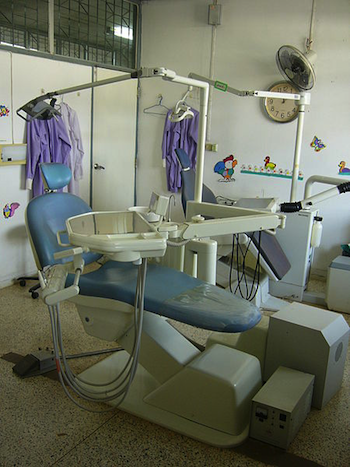The Theme of Health in Environmental Chemistry
Dental Aerosols: The Danger Lurking at Your Dentist's Office
We all know that when you flush the toilet, aerosols containing fecal matter are sprayed everywhere. This includes your toothbrush. What you might not know is that something similar happens at a dental appointment. As those motorized dental tools work to rid your mouth of plaque and food particles, they are also spraying the air with aerosols and droplets containing bacteria and blood.
As more and more patients are showing up at the office with resistant Staphylococcus aureus in the nasal and oral cavities, dental aerosols are becoming an area of concern for many dentists. Other micro-organisms found in dental aerosols include those associated with tuberculosis, conjunctivitis, SARS, West Nile Virus, and H1N1. There's even a special name for those diseases that can be spread via aerosols: ATD (Aerosol Transmissible Disease) or ATP (Aerosol Transmissible Pathogen).
Some studies show that when high-speed instruments are used, aerosols can travel more than 1.5 meters from the patient. Think about the last time you went to the office. Picture the instruments laid out nicely on that blue paper. Unless your dentist was trying to get in his 10,000 steps a day, those instruments were probably closer than 1.5 meters to your chair.
You're probably thinking that it doesn't really matter since those instruments are being sprayed with your aerosols, and being used in your mouth. What else is sitting near that lime green chair? The dentist, right? Over the course of an 8 hour day, he is sprayed with a good amount of aerosols. This is one reason the dentist wears that lovely surgical mask. Some dentists will even offer you a mask if they think you could harbor one of the ATD's or ATP's.
The mask will protect the eyes and nose, but aerosols will still end up on everything else. This is a particular concern in dental schools, in which there might be a big open room containing many chairs, or for those that are immune-suppressed. One solution is to have patients rinse with an antiseptic mouthwash prior to treatment. This has been shown to reduce the number of harmful microbes in dental aerosols.

Patients that visit dental rooms, like this one, in which there are more than one chair per room are particularly vulnerable to infection by dental aerosols. These rooms would be prime candidates for the antiseptic mouth treatment prior to treatment. Or maybe the patients could just be covered in biohazard suits… (Source)